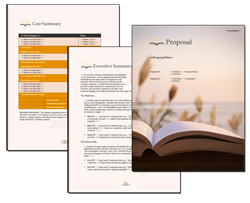
How to Write a Winning Education Proposal
Are you struggling to create an effective education proposal? Identifying potential funding sources is crucial when drafting an education proposal. Writing an education proposal is essential for securing funding and support. This article shows you a step-by-step guide to preparing a persuasive education proposal. From defining your vision to nailing the budget, we cover the must-know strategies for making your proposal robust and impactful. Get ready to raise your educational initiatives with these insights.
Key Takeaways
- Educational proposals vary from grant proposals for funding to project proposals for new programs and should align with the specific goals, needs, and desired educational outcomes.
- A winning education proposal must have a clear and compelling vision that matches potential funders' priorities and evaluation criteria. It must articulate the educational initiative's long-term goals and measurable benefits.
- The proposal should follow a structured format with key sections like an executive summary that offers a snapshot, a detailed project plan outlining objectives and methodology, and a budget breakdown with justified costs.
Types of Educational Proposals

Educational proposals come in various forms, each tailored to specific goals and requirements. Understanding the different types of proposals is the first step in creating a winning proposal. Understanding proposal guidelines and funding opportunities for every educational proposal is crucial. Let's look into the various types of educational proposals you might encounter.
One common type is the grant proposal. These are typically written to secure funding from government agencies, foundations, or other organizations. Identifying funding opportunities can help tailor the proposal to meet specific requirements. Grant proposals often focus on research topics such as the impact of STEM education on critical thinking or the efficacy of bilingual education in early childhood. In educational technology, proposals might address virtual reality's prospects or artificial intelligence's integration into personalized learning. Another significant area is teacher education and professional development, where proposals might focus on mentoring programs for new teachers or the impact of continuing education on teaching quality.
Another important type is the project proposal for new educational programs. These proposals are designed to introduce and implement new curricula, courses, or educational programs. For instance, a new educational program proposal might explore the role of arts education in developing emotional intelligence or address social and cultural issues in education, such as gender disparities in STEM fields. Additionally, education policy and leadership proposals might examine the impact of education policies on achievement gaps or the effect of school leadership styles on teacher morale. Each type of proposal has unique requirements and goals, but all share the common objective of improving educational outcomes and driving innovation.
Follow the Instructions
Most educational business proposals are written in response to grants with specific guidelines outlined in a Request for Proposal (RFP). These RFPs provide a detailed blueprint of the grantor's expectations, including the format, content, deadlines, and evaluation criteria. Following these guidelines to the letter is crucial, as adherence to them can result in the proposal being rejected on a technicality, regardless of the quality of the content or the project's merit.
The importance of following RFP guidelines cannot be overstated. These guidelines ensure that all proposals are evaluated equally, allowing the grantor to make fair and objective comparisons. By adhering strictly to the prescribed format, applicants demonstrate their attention to detail, respect for the grantor's requirements, and ability to follow instructions - traits often indicative of their capability to manage the grant effectively. Ignoring or misinterpreting even a single guideline can lead to disqualification, making it imperative for applicants to thoroughly review the RFP and ensure every aspect of their proposal aligns with the specified requirements. This diligence increases the chances of the proposal being considered and reflects a professional approach that can positively influence the grantor's perception of the applicant.
Creating Your Educational Vision

A clear and compelling vision is the cornerstone of any successful educational proposal. This vision guides the development of your proposed educational program and captures the interest of funding sources and decision-makers. Creating an educational vision involves articulating the desired outcomes and the broader impact of your program.
When creating your vision, think about the long-term goals of your educational project. What changes do you hope to see in students, educational institutions, or the broader educational landscape? A well-defined vision statement should express these aspirations clearly and concisely. For example, suppose your proposed educational program aims to enhance critical thinking skills through STEM education. In that case, your vision should highlight how this will benefit students and prepare them for future challenges.
Stakeholder engagement plays a vital role in shaping an educational vision. By involving key stakeholders, you ensure that the vision is comprehensive and aligned with the needs and expectations of those it aims to serve.
Winning support for your proposal often hinges on aligning your vision with the interests of potential funders. It's crucial to articulate your vision to resonate with their priorities to achieve this. Whether seeking a grant or institutional backing, your vision statement should demonstrate how your education program addresses a significant need and offers measurable benefits. This alignment strengthens your proposal and increases the likelihood of securing the necessary support to bring your educational ideas to life.
The Blueprint of an Education Proposal: Key Sections

An effective educational proposal follows a structured format that covers all key aspects. Understanding the key sections of a proposal is essential to present a winning case. The main sections include the executive summary, project plan, and budget breakdown.
Here's the order your proposal sections should follow: 1) introduce yourself, 2) summarize the project needs, 3) describe your solution and costs, and finally, 4) provide information about your organization, credentials, and capabilities.
The executive summary serves as the first impression of your proposal. It encapsulates the essence and urgency of the proposed educational program, providing a snapshot that can win over evaluators before they look into the detailed parts of the proposal. The executive summary should be able to stand alone as a summary of the major points, describing the project's aims and procedures in accessible terms.
The project plan should include the following:
- A clear set of objectives
- Expected significance and its relationship to the educational field
- Research design
- Ethical considerations
- Data analysis approaches
- Comprehensive timeline showcasing detailed planning and the sequence of activities
- Needs assessment to identify the specific needs the proposal aims to address
This will help map out the desired outcome of your proposal and establish methodological soundness.
Finally, the budget breakdown is critical for estimating costs and securing necessary funds. A well-defined budget and funding strategy demonstrate responsible financial planning. The budget should include detailed estimated costs, broken into direct and indirect costs, for the entire project period. Justifying the budget ensures that the costs are reasonable and aligned with the project's aims and methods.
Executive Summary: Your First Impression
The executive summary is the most important part of your proposal because it sets the stage for everything that follows. A well-written executive summary should:
- Capture the essence of your proposed educational program and its program objectives
- Highlight its urgency and relevance
- Provide a snapshot that can win over evaluators even before they look into the detailed parts of the proposal.
An effective executive summary should concisely describe the project's aims and procedures in terms accessible to a general audience. This section should stand alone as a summary of the major points, including the client's challenge, solution overview, and unique qualifications that set your proposal apart. By capturing the essence and urgency of your educational program, the executive summary serves as your first step toward winning support and making a lasting impression.
Project Plan: Mapping Out Success

In the project plan, you articulate a clear set of objectives and outline the steps needed to achieve them. This section should explain the project's expected significance and relationship to the educational field. A detailed timeline is essential to illustrate the sequence and duration of specific activities, ensuring that your planning is thorough and well-organized. An implementation timeline ensures that each project phase is executed promptly and organized.
In addition to setting objectives, the project plan must detail the research design, ethical considerations, and data analysis approaches. This establishes methodological soundness and shows how success will be measured. Furthermore, the project plan should outline how stakeholders are involved and managed through surveys, interviews, and workshops. By providing a comprehensive roadmap, the project plan demonstrates your commitment to achieving the desired outcomes and addresses potential challenges proactively.
Budget Breakdown: Estimating Costs for a Grant Proposal
A well-defined budget is crucial for the success of any educational proposal. It helps estimate costs and secure necessary funds. Your budget should include detailed estimated costs, broken into direct and indirect costs, for the entire project period. This level of detail demonstrates responsible financial planning and ensures that all aspects of the project are accounted for.
Conducting a cost-benefit analysis is essential to justify the budget and demonstrate the financial viability of the educational program.
Justifying the budget is equally important, showing that the costs are reasonable and aligned with the project's aims and methods. Including a budget and schedule document in the proposal reinforces your commitment to transparency and accountability. By carefully estimating costs and outlining a clear funding strategy, you can build a strong case for the financial viability of your educational program.
Tailoring Proposals with Proposal Templates and Proposal Kit Advantages
Proposal Kit is an invaluable resource for anyone involved in proposal writing. It offers a comprehensive suite of tools, including:
- Pre-written templates
- Samples
- Graphic options
- Automation software
Proposal Kit helps create a professional proposal format that meets specific requirements, ensuring your proposals are effective and visually appealing.
This allows users to tailor each proposal to address the client's unique needs, including specifics like the project's schedule, budget, and goals.
The professional design capabilities of the Proposal Kit enhance the overall impact of your proposal. With thousands of customizable templates and sample proposals tailored to educational endeavors, you can start with a solid foundation and personalize it to suit your project. The ability to incorporate visual elements further strengthens your proposal's effectiveness. By streamlining the proposal creation process, the Proposal Kit saves time and ensures a polished, professional appearance.
From Concept to Reality: Writing Process Insights

Writing a successful educational proposal involves well-defined steps, from initial research and data collection to drafting and refinement. Thorough research before writing the proposal provides a solid understanding of the project, helping to identify the needs and gaps the proposal can address. Gathering relevant data early establishes a foundation for creating an argument in the proposal.
Drafting the proposal involves the following steps:
- Create an outline that categorizes various aspects of the program, providing a roadmap for detailed writing.
- Refine the writing to ensure clarity, coherence, and the avoidance of jargon to make the proposal accessible to all stakeholders.
- Use clear, persuasive language throughout the proposal to communicate its goal and significance to the educational field.
- Conduct a proposal review to refine grammar, spelling, and overall clarity.
Including case studies and testimonials within the proposal helps to illustrate the success of similar educational programs, providing a model for the proposed initiative. Evidence of qualifications, through training, certifications, education, experience, or awards, solidifies the proposal's credibility. Following these steps, you can transform your concept into a reality that resonates with readers and secures the necessary support.
Research and Data Collection: Building a Strong Foundation
Clarifying the project's purpose and desired results at the initial stage is crucial to conceptualizing the project's entirety. The foundational step in creating an education grant is pinpointing the specific educational gap or challenge the project intends to solve. Examining successful grant applications can provide a roadmap for structuring information and deciding what to encapsulate in each section of the grant application proposal. Following these guidelines and presenting a well-prepared proposal is essential to requesting funding effectively.
In-depth research is essential to support the education project proposal and describe its transformative potential and benefits. Gathering and analyzing relevant data can create an argument showcasing evidence-based needs and your educational project's potential impact. Data analysis is essential in supporting the proposal and demonstrating its likely impact.
Drafting and Refinement: Creating a Compelling Narrative
Storytelling in grant proposals helps readers understand students' backgrounds, experiences, and challenges, engaging them with a narrative that reflects real-life scenarios. Writing a proposal involves being pragmatic and persuasive, presenting the educational challenges and goals without implying that specific technology tools are premature solutions.
The proposal should provide a detailed visualization of the student projects, emphasizing how their execution will tackle educational issues and achieve set goals. A clear proposal structure is crucial in making the proposal accessible to all stakeholders. It's recommended that the first draft of the proposal be reviewed by a qualified proofreader or editor to refine grammar, spelling, and overall clarity. Continuous refinement ensures the proposal is clear, coherent, and compelling to all stakeholders.
Using Evidence to Support Your Case

Including evidence-based solutions that address real educational needs demonstrates a proposal's potential as a model for other educators. Using varied sources in the proposal to substantiate the claim that the proposed solution can improve student learning adds to its overall strength. Supporting documentation plays a vital role in substantiating the claims made in the proposal, providing a solid foundation for the arguments presented. Examples of successful student projects can be a tangible measure of the educational strategy's effectiveness and potential impact.
Evidence of an organization or individual's qualifications through:
- training
- certifications
- education
- experience
- awards
This solidifies the proposal's credibility. By incorporating these elements, you can create a robust and persuasive case that resonates with evaluators and stakeholders.
Securing Buy-In: Addressing Stakeholder Interests
Securing buy-in from stakeholders is crucial for the success of any educational proposal. Here are some steps to follow:
- Draft an instructional vision statement.
- Collect feedback from various stakeholders.
- Refine and finalize the vision statement based on the feedback.
- Address any concerns and build consensus through a collaborative approach.
- Conduct a stakeholder analysis to understand and address stakeholder interests.
By following these steps, you can ensure that the instructional vision statement aligns with the interests of all stakeholders.
Linking the services offered in the proposal to the direct benefits they will provide is essential in solving the client's challenges and securing stakeholders' buy-in. Clear communication and demonstrating the tangible benefits of the proposed educational program can significantly increase the likelihood of success in acquiring funding and support.
Delivering and Following Up: Making Your Proposal Count

Delivering your proposal according to the specified method is just the beginning. Follow-up is essential to ensure the proposal was received and address any questions. A communication plan should be in place to ensure regular and clear communication with stakeholders post-delivery, specifying:
- Objectives
- Channels
- Frequency
- Formats suitable for each stakeholder group.
A well-defined communication strategy ensures regular and clear communication with stakeholders post-delivery.
Showing appreciation through letters, certificates, or events can strengthen relationships with stakeholders and increase the credibility of those proposing the educational project. Being proactive and engaging can make your proposal count and pave the way for successful implementation. A well-written cover letter can also enhance the impact of your proposal.
Here are some related samples included in every downloadable Proposal Pack
The AI Writer generates a first draft of these templates - customized to your company, client, and project - in just minutes, giving you a head start on editing. Get any Proposal Pack or Proposal Kit Professional, and all of these samples, and the AI Writer are included.
- Educational Grant Sample Proposal
- Educational Grant Sample Proposal #2
- Research Assistant Sample Proposal
- Corporate Event Planner Services Proposal
- USDA Federal Government Grant Proposal
- Training Services Sample Proposal
- Software and Hardware System Sample Proposal
- Charter School Educational Sample Proposal
- School Funding Request Sample Proposal
- Mining Safety Sample Proposal
- Youth Sports Program Sample Proposal
- Ranching Educational Grant Funding Sample Proposal
- Disaster Preparation and Training Sample Proposal
- Orphanage Non-Profit Funding Sample Proposal
Here are some related downloadable templates
The AI Writer generates a first draft of these templates - customized to your company, client, and project - in just minutes, giving you a head start on editing. Get any Proposal Pack or Proposal Kit Professional, and all of these templates and the AI Writer are included.
- Charter School Educational Proposal
- Computer Lab for Students Educational Proposal
- Distance Learning Education Proposal
- Educational Training for Special Needs Proposal
- Mobile Classroom Sales and Rental Proposal
- Music School Educational Proposal
- New College Curriculum Proposal
- Online School and Media Outlet Funding Proposal
- STEM Educational Program Proposal
- School Improvement Project Proposal
- Science Lab for Students Educational Proposal
Leveraging Tools for Efficiency: Proposal Kit's Role
Proposal Kit offers invaluable tools and templates that enhance the professional appearance of your proposals and save significant time. These education proposal templates are designed with prepared formats for headers, logos, and outline structures, giving your proposal a polished look.
Institutions can benefit significantly from using Proposal Kit's suite of related templates tailored for courses, grants, and programs, each designed to meet departmental requirements and expectations. By leveraging these resources, you can ensure your proposals are professional and efficiently managed from creation to submission.
 Proposal Kit Professional provides the most content, including legal contracts and a free design theme pack. Plus, advanced software features include custom branding and customizable quoting databases.
Proposal Kit Professional provides the most content, including legal contracts and a free design theme pack. Plus, advanced software features include custom branding and customizable quoting databases. Proposal Pack for Any Business covers this type of proposal and includes samples. There are also some commonly used specialty design themes available:
Proposal Pack for Any Business covers this type of proposal and includes samples. There are also some commonly used specialty design themes available:Photo Design Proposal Packs
Summary
Creating a winning educational proposal involves a comprehensive approach, from understanding the types of proposals to creating a clear vision, detailed project plan, and well-defined budget. The executive summary plays a vital role in making a solid first impression. At the same time, the project plan and budget breakdown provide the necessary details to map out success and estimate costs. Tailoring your proposals with the advantages of the Proposal Kit can streamline the process and enhance the overall impact.
Each step is critical in building a narrative, from conducting thorough research and data collection to drafting, refining, and using evidence to support your case. Addressing stakeholder interests, delivering the proposal, and following up are essential to secure buy-in and ensure successful implementation. Proposal evaluation is vital in ensuring the proposal meets all necessary criteria and stands out to evaluators. Leveraging tools like Proposal Kit can enhance your proposal's efficiency and professionalism, ultimately making your educational ideas a reality that drives meaningful change.
Frequently Asked Questions
How should a proposal be delivered to the client or committee?
Deliver the proposal according to the specified delivery method, then follow up with a phone call after a reasonable period to ensure it was received and address any questions.
What is the importance of customizing each proposal?
Customizing each proposal is crucial as it demonstrates personalized attention and helps differentiate it from mass marketing. This personalization can make the recipient feel valued and increase the likelihood of a positive response.
What are Proposal Packs designed for?
Proposal Packs are designed for writing educational proposals, such as RFP responses, grants, educational products, services, and funding. They provide a comprehensive solution for education-related proposal writing.
What is the purpose of writing an education business proposal?
Writing an education business proposal aims to present ideas and secure funding or support from key stakeholders. This is crucial for implementing innovative educational initiatives.
What should be included in the introduction section of a proposal?
In the introduction section of a proposal, include a cover letter introducing yourself, the purpose of the proposal, what action you seek, and your contact information. This will provide a clear overview and set the tone for the rest of the document.



 Cart
Cart
 Are you just looking for a template, sample, or software for your education project proposals? Click these links to skip down the page and get right to it.
Are you just looking for a template, sample, or software for your education project proposals? Click these links to skip down the page and get right to it.


















 Facebook
Facebook YouTube
YouTube Bluesky
Bluesky Search Site
Search Site